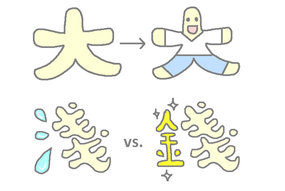
Top: comparing the shape of a word to a semantically related picture could be helpful for Chinese learners who have just started out. Bottom: pointing out which radicals different characters share in common could be more helpful for people who have studied Chinese for more than 12 months.
People often wonder about how important visual skills are for learning to read Chinese. Many researchers have devoted substantial efforts to understanding how simple visual skills, like being able to distinguish one 3-dimensional pattern with geometric shapes or designs (but NOT print) might explain children's subsequent reading skills. Evidence is mixed and not very strong. For children and adults who are just getting exposed to Chinese at the very beginning, basic visual skills are somewhat associated with Chinese word reading and writing. However, this effect does not seem to last too long. Once readers start to understand the basic structures of Chinese by the radicals that comprise them, their basic visual skills are no longer uniquely important for learning to read Chinese. Instead, Chinese orthographic skills related to character structure are particularly useful. If you have a child or adult who is just starting out, it will be great to tell him or her that 大 (Cantonese: /daai6/; Mandarin /dà/) looks like a person with his arms held wide or 口 (Cantonese: /hau2/; Mandarin /kǒu/) looks like a box. However, after the student has been studying for more than about 12 months, such techniques might not be so helpful anymore. Rather, pointing out which radicals different characters share in common might help more.
One other interesting finding from our research and that of others (e.g., Professor Andreas Demetriou from Cypress) is that once children have learned Chinese for a couple of years, compared to children learning alphabetic orthographies, they tend to develop better visual basic skills. That is, compared to alphabetic readers, Chinese children tend to have superior visual skills in relation to visual designs (again, shapes or designs; we are not talking about print). In a sense, we seem to have found that learning to read Chinese makes us visually smarter!